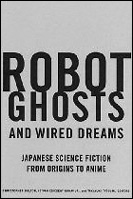Robot Ghosts and Wired Dreams: Japanese Science Fiction from Origins to Anime

- Editor
- Christopher Bolton, Istvan Csicsery-Ronay, Takayuki Tatsumi
- Publisher
- University of Minnesota Press
- Published
- 10 November 2009
by Jasper Sharp
From the same publishers as the Mechademia journal, and with essays by many of the same writers, comes this wonderful anthology that does exactly what I claimed most books on anime don't. i.e. put it into some sort of context, with half the first five of the book's eleven chapters focusing on prose science fiction and the other half on animated science fiction. As is pointed out in the introduction, very little Japanese sci-fi literature has been translated, which makes it rather difficult for foreign viewers to work out where anime and manga sit within the broader scheme of things. Miri Nakamura's opening essay, 'Horror and Machines in Prewar Japan: The Mechanical Uncanny in Yumeno Kyusaku's Dogura Magura' really had me slathering to get a hand on a English-language copy of this seminal work from 1935, which sounds absolutely extraordinary, but alas, only a French translation exist. One hopes studies such as this one will encourage publishers to give it a try.
Nakamura's piece comes illustrated with some amazing photos of Japan's first robot, (jinzo ningen, or 'artificial human'), which are worth the cover price alone. Created in 1928 by the scientist Makoto Nishimura, it was seen as heralding the birth of Japan's "machine age" (kikai jidai), which gave rise to early Japanese science fiction and ero-guro writing. In fact, when you consider that the world's first magazine devoted to sci-fi was only published in 1926 by Hugo Gernsback, it becomes apparent how early the Japanese were in on the game.
Thomas Schnellbacker provides an interesting analysis of the precedents leading up to Sakyo Komatsu's Japan Sinks, in 'Has the Empire Sunk Yet? The Pacific in Japanese Science Fiction', but for me the cherry on the cake of this section has to be William Gardner's 'Tsutsui Yasutaka: Multimedia and Authorship', a study of the writer whose experimental multimedia capers led to the works Gaspard of the Morning (1993) and the 1993 source novel for Satoshi Kon's Paprika.
The anime section is pretty good too, with essays including Sharalyn Orbaugh's 'Sex and the Single Cyborg: Japanese Popular Culture Experiments in Subjectivity' and Livia Monet's 'Invasion of the Woman Snatchers: The Problem of A-Life and the Uncanny in Final Fantasy: The Spirits Within.' Top of the pile in this half is editor Christopher Bolton's contribution 'The Mecha's Blind Spot: Patlabor 2 and the Phenomenology of Anime.' The more I read of Bolton's work, the more I'm convinced he's one of the more profound voices in this area of studies.
In summary, Robot Ghosts and Wired Dreams is an essential read, full or startling insights and fantastic nuggets of information, and not just for anime students either. Go buy a copy.